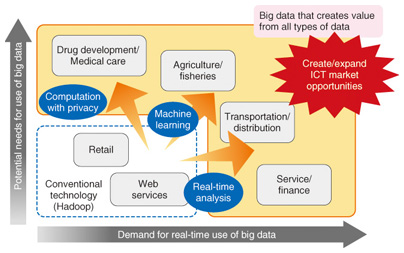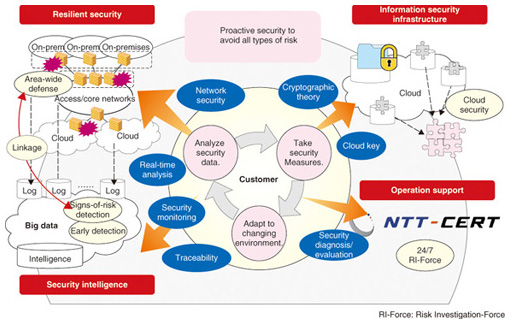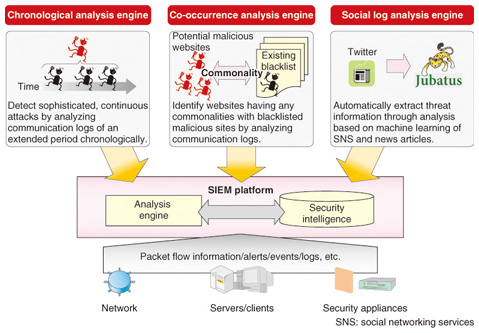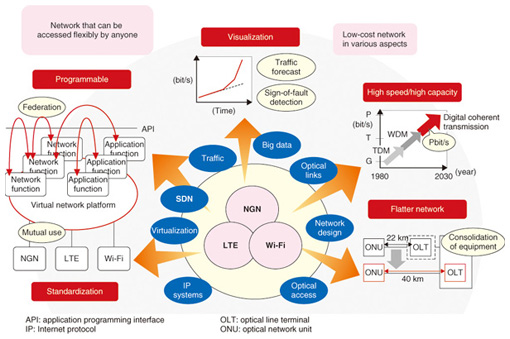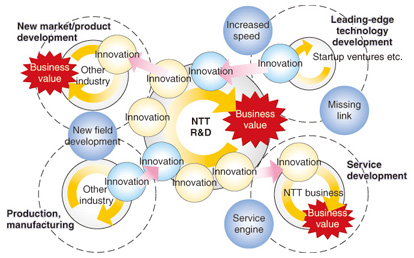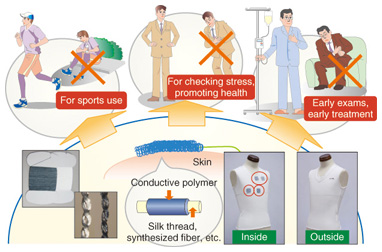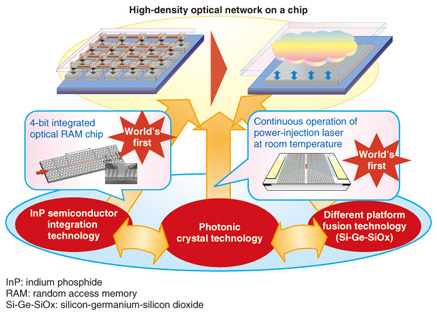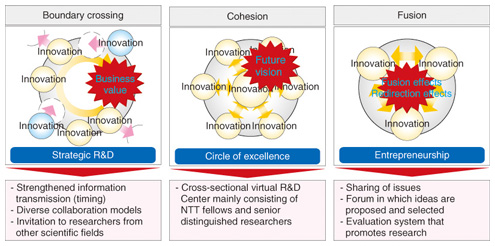 |
|||
|
|
|||
|
Feature Articles: Keynote Speeches at NTT R&D Forum 2013 Vol. 11, No. 4, pp. 8–20, Apr. 2013. https://doi.org/10.53829/ntr201304fa2  Chain Reaction InnovationAbstractThis article introduces the activities of the NTT R&D (research and development), Laboratory Group, which is pressing forward to create new value in information and communications technology by initiating "chain reactions of innovations" in order to pave the way to becoming a valued partner. This is the aim of the group's Medium-term Management Strategy entitled Towards the Next Stage. This article is based on the speech presented by Hiromichi Shinohara, Executive Vice President, Director, Research and Development Planning Division, NTT, at NTT R&D Forum 2013, held on February 14¡Ý15, 2013. 1. Recent priorities for NTT R&DLet me start by discussing the priority areas for the NTT R&D (research and development) Laboratory Group (NTT R&D) in the past year from three perspectives: expansion of our network infrastructure, which is the bread and butter of the NTT Group; our strategic foothold for growth; and the improvement in NTT R&D’s reputation. 1.1 Expansion of our network infrastructureOur efforts in the past year to expand our network infrastructure have resulted in significant achievements, including the development of the world’s highest-density multifiber optical cable, an anti-disaster wireless system, and the world’s highest capacity optical transmission, measured in petabits per second (Pbit/s). We have developed an optical fiber ribbon that sparsely bonds several optical fibers in order to build a multifiber optical cable. In addition, we have developed the world’s highest density cable, which is thinner by about 30% and lighter by about 60% than a comparable conventional cable. This achievement has been instrumental in cutting capital expenditure in access networks, reducing both the purchase and installation cost of new optical fibers and the need to install additional conduits. Since the Great East Japan Earthquake struck the country two years ago, we have been redoubling our efforts to make our networks resistant to disasters (Fig. 1). For the past year, in particular, we have focused on developing anti-disaster wireless systems for use in access networks, which will improve backup support in both terrestrial and satellite systems.
In the area of inter-office optical transmission, we are now working on the third-generation technology of digital coherent transmission. This follows the development of first-generation technology of electrical multiplexing and time-division multiplexing (TDM) and second-generation technology of optical amplification and wavelength-division multiplexing (WDM). In this fiscal year, by combining digital coherent transmission and multi-core optical fiber technologies, we succeeded, for the first time in the world, in sending an optical transmission at 1 Pbit/s in an experiment. At this rate, about 5000 movies, each 2 hours long, can be sent in a second. The unified management system (UMS) is in the limelight as a means to improve work efficiency in the field. This system is capable of generating scenarios to automate conventional human operations on a terminal for nonroutine or highly region/field-dependent tasks, which are tasks that are difficult to computerize. The UMS reduces the human workload and improves work efficiency in the field. The use of the UMS has expanded dramatically in the past year, which is enabling NTT operating companies to reduce their operating expenditure. 1.2 Strategic footholds for growthNTT R&D’s technologies that will serve as strategic footholds for growth include natural language processing, big data processing, and an energy management system (EMS). These technologies have begun to harmonize with the business models of NTT operating companies in the past year. Shabette Concierge* (Talking Concierge), an extremely popular application provided by NTT DOCOMO, uses our natural-language processing technology to understand a question posed by a user, and to extract the correct reply from a database. In the area of big data, an area with great business potential, a technology called Jubatus is attracting attention because it satisfies the competing requirements of intelligent and real-time analysis (Fig. 2). In 2012, NTT DATA concluded a contract with Twitter for its firehose, which is the full stream of data coming in the form of tweets, so that Jubatus can be used to classify tweets in a variety of categories such as type of business or product. This capability is already being used for real-time customer relationship management (CRM).
The NTT Group, the Hanshin-Hankyu Group, and Hakuhodo, Inc. are jointly conducting a trial on big-data-based O2O (online to offline) marketing in a commercial facility in Osaka. The NTT laboratories are involved in this project and are using clustering technology to screen big data for information that is easy to use and valuable for marketing. In the area of electric power, energy consumption has long been a major social issue. NTT East and NTT West have been carrying out a feasibility test on visualization of home energy consumption. This test uses NTT laboratories’ technology to estimate the power consumption of all the appliances in the home. Instead of requiring a power sensor to be attached to each appliance, this technology requires only one sensor to be installed on a distribution board. It analyzes the waveform of the current from each appliance and displays the power consumption of each appliance. This technology reduces the cost of introducing a service to visualize power use, and thus, this technology is expected to promote the widespread use of the power consumption visualization service. 1.3 Rise in external reputationThe laboratories in the NTT R&D Group have been producing outstanding results in the field of basic research in recent years, as demonstrated by the publication of leading-edge studies on quantum memory and a GaN (gallium nitride) semiconductor device in Nature, and the publication of research related to a quantum computer in Science. These remarkable activities have contributed to NTT being ranked second in the world in the number of citations in the field of physics. In the world of industry, for two years in a row NTT has received a Top 100 Global Innovators Award from Thomson Reuters, which selects the world’s most innovative enterprises from the aspect of intellectual property. NTT also received the Master of Sound Award for its reverberation control technology from the Japan Audio Society. Professor emeritus Yoshihisa Okumura (Kanazawa Institute of Technology), a past researcher at NTT, received the Charles Stark Draper Award, which is known as the “Nobel Prize of Engineering,” from the National Academy of Engineering in recognition of his pioneering contributions to the development of the cellular telephone service in its early days. In addition, NTT received the IEEE Milestone Award for its contributions to the international standardization of the G3 (Group 3) facsimile. As research laboratories of a national flag carrier, NTT R&D will continue not only to contribute to the growth of the NTT Group, but also to fulfill its responsibility for the development of industry as well as our academic society.
2. Activities towards a new stageThe directions NTT R&D will take to fulfill the NTT Medium-term Management Strategy are described below. This strategy declares our determination to evolve from being a telecom provider to a valued partner for our customers. This involves changing from the conventional stance of providing information and communications technology (ICT) services to a new stance in which we identify our value in using ICT to support our customers’ activities on the Internet and in the real word, thereby becoming a sought-after partner for our customers. For this transition, we believe that in addition to our conventional efforts to make ICT services faster, larger in capacity, and lower in cost, NTT R&D needs to advance in three directions: personalization, to enable anyone to use any service conveniently, value creation, to link all data to provide direct benefits to users, and adaptive access, to enable anyone to use all types of network and information processing easily and at an affordable price. These three aspects are described in more detail below. 3. Personalization3.1 Personalized servicesTo achieve personalization, it is necessary to satisfy three requirements. (1) The user interface (UI) should be able to learn and should be intuitive and optimized for individual users, including seniors and small children; (2) information suitable for user preferences and special purposes should be available anywhere and anytime; and (3) a service environment should be in place that is transparent to terminal specifications or type so that the latest applications can be accessed using even an old personal computer (PC). Personalized services would provide valuable user experiences regardless of the age or sex of the user, and would enable them to freely access a variety of services. For this to happen, we need to build three environments. (1) an environment that understands the needs of individual customers and delivers appropriate information in a manner appropriate to individual needs; (2) an environment that links several services to provide value to customers; and (3) a user environment that provides an intuitive, user-friendly interface and is not constrained by terminal specifications (Fig. 3). The activities we are energetically working on to build these environments are described below.
3.2 User interface technologiesVoice input/output technology is growing in importance as a user-friendly interface. The NTT laboratories are working to enhance recognition accuracy in voice input and listenability in voice output despite the presence of noise, both of which are critical features in practical situations (Fig. 4).
A forte of the NTT laboratories is statistical machine translation, which is a technology that uses machine learning to automatically create (and use) probabilistic models from data available on the Internet and written in different languages. We will strengthen our research into this technology and combine it with other speech technologies with a view to developing a telephone that automatically translates in real time. An example of our research into intuitive interfaces is a unique technology that records the speed and intonation with which the user reads the characters shown on a display, and reproduces these features to convey the feeling of the writer to the reader. Conveying information that is hard to express in characters in this way will expand the breadth of communication even in short messages such as email. Edge computing, which we have begun to develop recently, is intended to provide an entirely new user experience by placing a microcloud near the customer (Fig. 5).
4. Value creationWith regard to value creation, we are focusing on a cloud that can be provided quickly, securely, and at low cost, and big data handling that creates value from all types of data. NTT R&D has been studying cloud computing and big data from five perspectives: security, economy, speed and flexibility, value creation, and scalability. 4.1 Cloud computingThe development of an integrated cloud controller based on a virtual network and open source software technologies has resulted in the establishment of infrastructure technology for seamless global clouds, in which user environments can be transferred between datacenters or between on-premises sites and clouds. From 2013 onwards, we will aim to develop completely virtual clouds that can securely store confidential data based on dynamic optimization of resource allocation, computation with privacy, and secret distribution technologies. In the slightly more distant future, our target will be to achieve autonomous distributed clouds by developing a distributed OS (operating system), a distributed processing language, etc. (Fig. 6).
One of our activities in this area is an open source technology called Sheepdog, which combines multiple general-purpose PC servers and bundles their local disk drives to form a huge storage unit. This technology is inexpensive due to its use of general-purpose PCs. It also has the capacity for flexible growth and is highly resistant to failure due to its distributed configuration. Sheepdog can often perform better than conventional storage systems that use dedicated hardware. We have released an open source technology named Ryu as an integrated development tool kit for a virtual network controller. By using Ryu as a platform, the user can develop application programs for virtual networks without worrying about the control of virtual network devices. 4.2 Big dataUp to now, NTT has only been analyzing its own big data, such as traffic data, for internal use. However, we are going to utilize technologies owned by NTT laboratories such as those for real-time analysis, machine learning, and computation with privacy, to broaden the scope of the analysis of big data to new areas where no significant efforts have so far been made in order to exploit big data in such areas as finance, transportation and distribution, agriculture and fisheries, and drug development and medical care (Fig. 7).
For example, with a view to promoting the use of Jubatus, we held a contest called the “Jubatus Challenge” as a way to solicit ideas from outside NTT for real-time analysis of big data using Jubatus. We will accelerate open innovation activities like this. We have developed the world’s fastest algorithm for the analysis of graphical data. This technology is 10 times faster than existing technologies in clustering and several tens of times faster in page ranking. For example, it can compute links between individuals in the entire Japanese population in as little as three minutes. It can be used in a broad range of fields such as drug development, where an enormous amount of computation is required to discover the factors that provide the highest efficacy. We are also developing a technology that can process at high speed the multidimensional analysis of big data that involve multiple attributes. Usually, the amount of computation grows exponentially with the number of attributes handled. By using machine learning, the NTT laboratories have dramatically reduced the amount of computation required, making it possible to efficiently discover hidden links, which are hard to detect at a glance, between items of data. 5. Adaptive accessWe are approaching adaptive access focusing on three key factors: strengthened security, easy network access, and reduced network cost. 5.1 SecurityThere have been three important aspects of security services in recent years: analyzing threats to security, taking security measures based on the analysis, and adapting to the changing environment, for example, changes in government policies regarding information security. NTT R&D is developing proactive security technologies to avoid all types of risk through four activities that address these aspects (Fig. 8). Security intelligence is a technology enabling early detection of a risk or detection of signs of a risk through techniques such as malware analysis. Resilient security is a technology to ensure that customer facilities such as networks and clouds are well protected by optimally allocating and operating security devices such as firewalls based on the information obtained above. We are also developing technology for an information security infrastructure such as cloud cryptography to defend user data from attacks, and are hosting NTT-CERT, which ensures proper operation of security services. It is important in the security field that both R&D and operation teams move forward together like the two wheels of a cart. We will manage research into security in a way that such an ecosystem will emerge.
In building a platform for security information and event management (SIEM), an endeavor that is being strengthened by the NTT Group, the NTT laboratories are developing three engines: chronological analysis, co-occurrence analysis, and social log analysis engines (Fig. 9). The SIEM platform makes sophisticated security operation possible by analyzing a variety of logs to detect, early on, security threats that have so far been difficult to identify, such as targeted attacks, and to produce security intelligence.
To counter malware, we are developing a technology that dynamically analyzes items of malware that have been collected using a decoy system (honeypot), with tangible results. The performance of our technology is surpassing that of major Internet providers in terms of the number of items of malware detected from honeypots and of the number of items detected by dynamic analysis and entered into the blacklist. Security is one of the major issues to be tackled by the new R&D site to be established in North America, called NTT I3 (NTT Innovation Institute, Inc.). The location of this site is very strategic, and we plan to capitalize on that to provide a market-in service quite soon, and to strive to achieve our target of becoming one of the world’s top-notch operators in the field of security by 2014. 5.2 NetworksIn Japan, the NGN (Next-Generation Network) and the LTE (Long-Term Evolution) network have already been deployed. They have evolved from the phase of building their infrastructures to that of making full use of them. An issue that will grow in importance is how to make the networks, including the above two networks and a Wi-Fi network, easy to use and useful for our customers (Fig. 10).
With a view to making the networks flexible and accessible by anyone, the NTT laboratories are developing technology to standardize applications of different networks in order to make them easily accessible from any network. In addition, we are studying a mechanism to facilitate the federation between functions in different networks and to allow efficient network operation by making network functions programmable. However, reducing network costs is also one of our major goals. Our efforts to reduce our capital expenditure in networks include increasing network speed and capacity, for example, through the use of petabit transmission, to handle ever-growing traffic, and consolidating network facilities by extending the intervals between repeaters in optical fiber links. To reduce operating costs, we have been working on ways to visualize the network operation state in order to facilitate traffic forecasting and to detect signs of impending network failures. A key for these activities is virtualization technology. For example, in cooperation with NTT DOCOMO Research Laboratories, we are developing a technology that will allow us to respond to changes in demand efficiently and to recover from large-scale failures rapidly by applying software-defined network (SDN) technology to carriers’ networks. We are also studying how to use virtualization technology in the platform for network systems. Currently, communication servers are designed to serve a specific region and a specific service, which raises the cost and reduces the flexibility of these servers. NTT R&D is undertaking research into a platform that uses off-the-shelf PC servers for any services and on which the number of servers can be scaled up or down in response to fluctuations in demand. For example, in times of a disaster, such as the Great East Japan Earthquake, it will be possible to prevent network congestion or disruption if servers handling communication to disaster-hit areas can be increased in number instantaneously and flexibly. Further, it is also imperative to utilize big data that have an impact on networks. 6. Chain reaction of innovationLastly, the directions in which the management of NTT R&D is advancing are described below. The laboratories in the NTT R&D group used to cover the complete cycle of innovation from research into leading-edge technologies to development of devices and systems that use them, enhancement of reliability and scalability, and commercial introduction. However, in the current state of telecommunications, in which changes in the business environment and technical trends continue to accelerate, such a closed-loop approach is no longer effective. We believe that it is necessary to add the following three links to the conventional cycle of innovation in order to initiate chain reactions of innovations. 6.1 Boundary crossingBoundary crossing means that innovation activities go beyond the conventional framework of NTT laboratories. These activities can be broadly classified into the following patterns (Fig. 11).
The first occurs in a case where the circle of innovation within the laboratories is incomplete, and the missing links are filled by introducing external technologies to speed up innovation. Specific examples of this case include activities related to clouds and SDN, both of which capitalize on open-source software, and the development of Jubatus to analyze big data. In the second pattern, technologies developed in the laboratories are inserted into the cycle of innovation within NTT operating companies. Instead of providing a complete system, the laboratories offer individual technical elements as service engines. The natural-language processing technology offered for Shabette Concierge (talking concierge) is such an example. The third pattern is to have technologies originally developed at the laboratories for telecommunications purposes used in other industries as part of their cycles of innovation so that these technologies will create value in fields entirely different from telecommunications. An example of recent R&D results that fit this pattern is the production of body-friendly bio-electrodes, which are made by blending a conductive polymer, PEDOT-PSS (poly(3,4-ethylenedioxythiophene) poly(styrenesulfonate), into a fabric such as silk. Just by wearing a shirt made of that fabric, a person can have his/her electrocardiogram signal recorded (Fig. 12). This was a result of the intensive interactions between our researchers and medical doctors in the field in a joint endeavor. However, before this result can be introduced commercially, it will be necessary to address many issues that are completely outside the expertise of NTT laboratories, for example, mass production of the relevant thread and introduction of the relevant product into actual medical settings. We therefore find it necessary to accelerate boundary crossing.
6.2 CohesionCohesion in promoting the chain reaction of innovation means that a very strong innovation will be connected to related innovations, which will synergistically produce more and greater innovations. For example, the NTT Nano-Photonics Center, which consists of members from different NTT laboratories, is creating innovations by combining the world’s top-class photonic crystal technology with cutting-edge technologies from different laboratories (Fig. 13). The Center has produced a number of outstanding results in recent years. This is thanks to the fact that a powerful technology has been combined with other cutting-edge technologies, and all the members involved in developing these technologies have come together in pursuit of a common grand dream (putting a high-density optical network onto a chip, in this case).
6.3 FusionFusion in encouraging the chain reaction of innovation means that multiple innovations are made to interact with each other on an equal basis so that problems not solved by one innovation can be solved by other innovations, thereby creating more value than the simple sum of all the innovations. For this to happen, it is extremely important that researchers engaged in different innovations share a common understanding of the issues and different innovations involved. For example, our small-diameter, low-friction indoor optical fiber cable is an unparalleled innovation that resulted from a fusion of the small-diameter technology developed by the Optical Fiber Research Group and the low-friction technology developed by the Materials Research Group. In a simulation conducted to calculate radio propagation loss, the Wireless Communication Research Group achieved automatic extraction of terrain and building information, but it took 100 hours to extract relevant information for each office. By fusing this technology with the UMS, an innovation of the Operations Research Group, it has become possible to reduce the extraction time to just one hour per prefecture. We will also pursue what is called a redirection effect in innovation, which is a synergistic effect derived as a byproduct of research that was originally aimed at something else. 6.4 Management approaches that accelerate new chain reactions of innovationFinally, let me summarize the gist of the three above-mentioned management approaches that are intended to accelerate a new chain reaction of innovation (Fig. 14).
Boundary crossing is intended to initiate a cascade of innovation, and to achieve this, NTT R&D needs to seek to become an R&D partner selected by external bodies, including those in other industries, just as the NTT Group seeks to become a valued partner for its customers. To achieve this purpose, we will establish a variety of collaboration models and strengthen efforts to transmit information to the public about our R&D results in a timely and effective manner. Furthermore, we will do away with perfectionism, which places too much emphasis on perfection at the cost of missing prime introduction opportunities, and will invite participation from researchers in other scientific fields. In cohesion, which is intended to promote a cascade of innovation, the key is to form virtual R&D centers that primarily consist of NTT fellows and senior distinguished researchers from different laboratories. We are expanding this approach from the nano-photonics field to other technical fields. In fusion, where the goal is to produce a cascade of innovation, we find it necessary to establish a forum in which ideas that have succeeded or failed are disclosed and chosen by others. We will also study a new personnel evaluation system that will encourage such interactions. NTT R&D is striving to become a valued partner and an engine powering the growth of the NTT Group by developing new mechanisms to initiate cascades of innovation, in addition to following the conventional approach to innovation. |
|||







